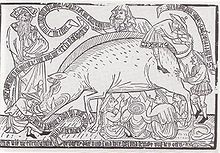Judensau: Difference between revisions
No edit summary |
→Background and images: Judensau woodcut image text |
||
| Line 3: | Line 3: | ||
==Background and images== |
==Background and images== |
||
[[Image:Judensau Blockbuch.jpg|thumb|left| |
[[Image:Judensau Blockbuch.jpg|thumb|left|Woodcut from [[Staatliche Graphische Sammlung|Kupferstichkabinet]], Munich, ca. 1470, showing a ''Judensau''. The Jews, identified by the "Jews' hat" that the Christian authorities imposed upon them, are suckling from a pig and eating its excrement. The banderoles display rhymes mocking the Jews.]] |
||
The Jewish prohibition of pork comes from Torah, in the book [[Leviticus]], Chapter 11, verses 2 through 8. The arrangement of [[Jew]]s surrounding, suckling, and having intercourse with the animal (sometimes regarded as the [[devil]]), is a mockery of Judaism and example of [[Antisemitism|antisemitic]] [[propaganda]]. |
The Jewish prohibition of pork comes from Torah, in the book [[Leviticus]], Chapter 11, verses 2 through 8. The arrangement of [[Jew]]s surrounding, suckling, and having intercourse with the animal (sometimes regarded as the [[devil]]), is a mockery of Judaism and example of [[Antisemitism|antisemitic]] [[propaganda]]. |
||
Revision as of 18:58, 13 September 2011
| Part of a series on |
| Antisemitism |
|---|
 |
|
|
Judensau (German for "Jews' sow" or "Jewish sow")[1] is an image of Jews in obscene contact with a large sow (female pig), which in Judaism is an unclean animal, that appeared during the 13th century in Germany and some other European countries; its popularity lasted for over 600 years.[2]
Background and images

The Jewish prohibition of pork comes from Torah, in the book Leviticus, Chapter 11, verses 2 through 8. The arrangement of Jews surrounding, suckling, and having intercourse with the animal (sometimes regarded as the devil), is a mockery of Judaism and example of antisemitic propaganda.
The image appears in the Middle Ages, mostly in carvings on church or cathedral walls, often outside where it could be seen from the street (for example at Wittenberg and Regensburg), but also in other forms. The earliest appearance seems to be on the underside of a wooden choir-stall seat in Cologne Cathedral, dating to about 1210. The earliest example in stone dates to ca. 1230 and is located in the cloister of the cathedral at Brandenburg. In about 1470 the image appeared in woodcut form, and thereafter was often copied in popular prints, often with antisemitic commentary. A wall painting on the bridge tower of Frankfurt am Main, constructed between 1475 and 1507 near the gateway to the Jewish ghetto and demolished in 1801, was an especially notorious example and included a scene of the ritual murder of Simon of Trent.[3]
As an unrelated development, during the Nazi period, Judensau was used as an insulting appellation in German. Although this word is identical in form to the name of the image, it is historically separate and morphologically opposite, and translates as "Jewish sow" rather than "Jews' sow".
Judensau in Wittenberg

The city of Wittenberg contains a Judensau from 1305, on the facade of the Stadtkirche, the church where Martin Luther preached. It portrays a rabbi who looks under the sow's tail, and other Jews drinking from its teats. An inscription reads "Rabini Shem hamphoras," gibberish which presumably bastardizes "shem ha-meforasch" (see Shemhamphorasch). The sculpture is one of the last remaining examples in Germany of "medieval Jew baiting." In 1988, on the occasion of the 50th anniversary of the Kristallnacht, debate sprung up about the monument, which resulted in the addition of a sculpture recognizing that during the Holocaust six million Jews were murdered "under the sign of the cross."[4]
In Vom Schem Hamphoras (1543), Luther comments on the Judensau sculpture at Wittenberg, echoing the antisemitism of the image and locating the Talmud in the sow's bowels:
Here on our church in Wittenberg a sow is sculpted in stone. Young pigs and Jews lie suckling under her. Behind the sow a rabbi is bent over the sow, lifting up her right leg, holding her tail high and looking intensely under her tail and into her Talmud, as though he were reading something acute or extraordinary, which is certainly where they get their Shemhamphoras.[1]
Partial list
Some of these sculptures can be found at some churches today.
- Aarschot (Notre Dame Church)
- Bamberg (Cathedral)
- Basel in Switzerland (Cathedral)
- Brandenburg (Cathedral)
- Cadolzburg
- Colmar, Église Saint-Martin (2 representations)
- Cologne, underside of a choir-stall seat in the Cathedral (probably the earliest example) and in Church of St. Severin)
- Eberswalde
- Erfurt (Cathedral)
- Gniezno in Poland (Cathedral) [citation needed]
- Heilsbronn (Cathedral)
- Lemgo (St Marien)
- Magdeburg (Cathedral)
- Metz in France (Cathedral)
- Nuremberg (St Sebaldus Church)
- Regensburg (Cathedral)
- Remagen (Gate post)
- Uppsala in Sweden (Cathedral)
- Wiener Neustadt in Austria
- Wimpfen (Church of St. Peter)
- Wittenberg (Town church)
- Xanten (Cathedral)
- Zerbst (St Nicolas Church)
Image gallery
-
Judensau at the Cathedral of Brandenburg
-
Judensau on the Cathedral of St. Martin in Colmar
-
Judensau on the Cathedral in Heilsbronn
-
Judensau at the Cathedral of St. Peter in Regensburg
-
Judensau at the minster in Wimpfen
-
Judensau on the Wittenberg Parish Church, cited by Luther
-
Woodcut of the Bridge Tower at Frankfurt, showing martyrdom of Simon of Trent above a Judensau
-
Illustration from an antisemitic book (Aarau 1822)
See also
References
- ^ a b Wolffsohn, Michael (1993). Eternal guilt?: forty years of German-Jewish-Israeli relations. Columbia University Press. p. 194. ISBN 9780231082754.
- ^ Madigan, Kevin (2005). "Judensau". In Richard S. Levy (ed.). Antisemitism: a historical encyclopedia of prejudice and persecution. Vol. Vol 1: A-K. ABC-CLIO. pp. 387–88. ISBN 9781851094394.
{{cite book}}:|volume=has extra text (help) - ^ Schreckenburg, Heinz, The Jews in Christian Art, p.331-337, 1996, Continuum, New York, ISBN 0826409369. Cologne illustrated p. 332, Frankfurt pp. 335-7
- ^ Lopez, Billie (1997). Traveler's guide to Jewish Germany. Pelican Publishing Company. pp. 258–60. ISBN 9781565542549.
{{cite book}}: Unknown parameter|coauthors=ignored (|author=suggested) (help)








